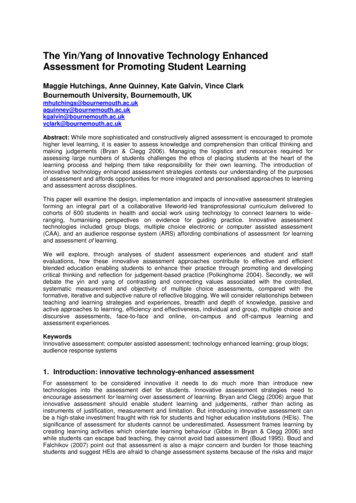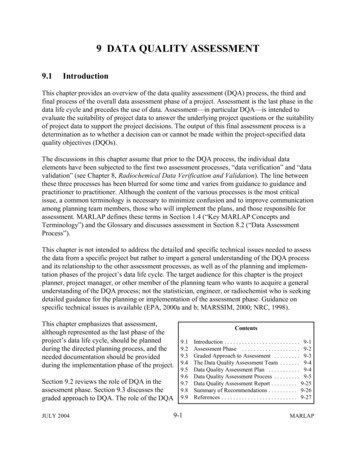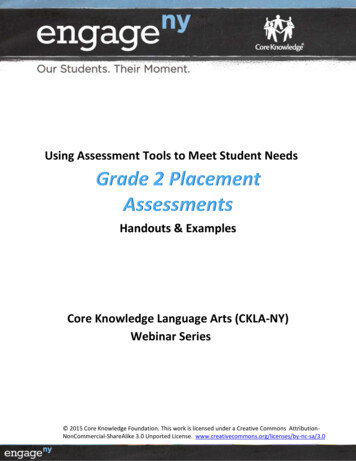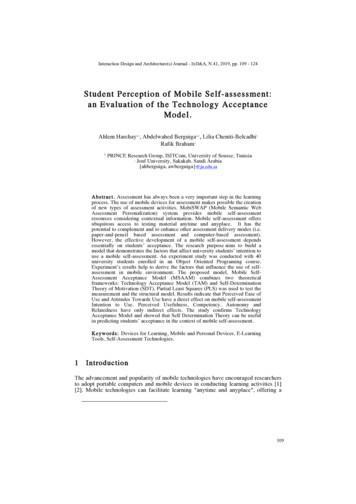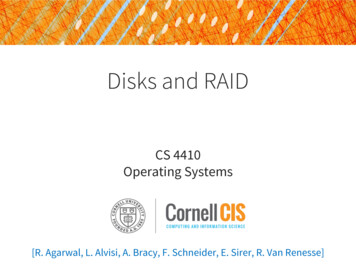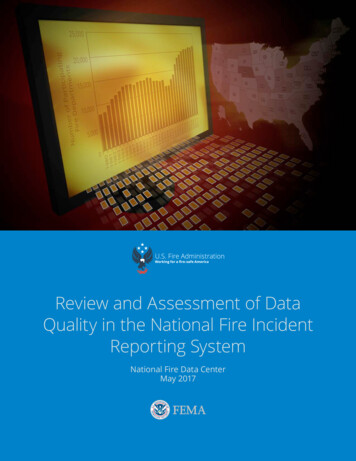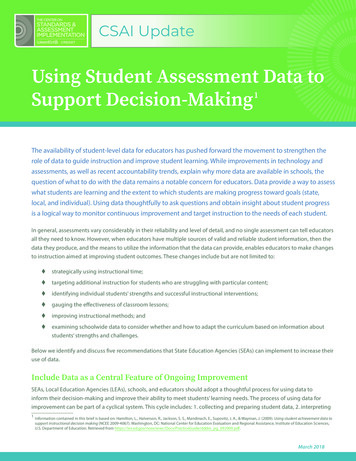
Transcription
CSAI UpdateUsing Student Assessment Data toSupport Decision-Making 1The availability of student-level data for educators has pushed forward the movement to strengthen therole of data to guide instruction and improve student learning. While improvements in technology andassessments, as well as recent accountability trends, explain why more data are available in schools, thequestion of what to do with the data remains a notable concern for educators. Data provide a way to assesswhat students are learning and the extent to which students are making progress toward goals (state,local, and individual). Using data thoughtfully to ask questions and obtain insight about student progressis a logical way to monitor continuous improvement and target instruction to the needs of each student.In general, assessments vary considerably in their reliability and level of detail, and no single assessment can tell educatorsall they need to know. However, when educators have multiple sources of valid and reliable student information, then thedata they produce, and the means to utilize the information that the data can provide, enables educators to make changesto instruction aimed at improving student outcomes. These changes include but are not limited to: strategically using instructional time; targeting additional instruction for students who are struggling with particular content; identifying individual students’ strengths and successful instructional interventions; gauging the effectiveness of classroom lessons; improving instructional methods; and examining schoolwide data to consider whether and how to adapt the curriculum based on information aboutstudents’ strengths and challenges.Below we identify and discuss five recommendations that State Education Agencies (SEAs) can implement to increase theiruse of data.Include Data as a Central Feature of Ongoing ImprovementSEAs, Local Education Agencies (LEAs), schools, and educators should adopt a thoughtful process for using data toinform their decision-making and improve their ability to meet students’ learning needs. The process of using data forimprovement can be part of a cyclical system. This cycle includes: 1. collecting and preparing student data, 2. interpreting1Information contained in this brief is based on: Hamilton, L., Halverson, R., Jackson, S. S., Mandinach, E., Supovitz, J. A., & Wayman, J. (2009). Using student achievement data tosupport instructional decision making (NCEE 2009-4067). Washington, DC: National Center for Education Evaluation and Regional Assistance, Institute of Education Sciences,U.S. Department of Education. Retrieved from m pg 092909.pdf.March 2018
CSAI UpdateUsing Student Assessment Data to Support Decision-Makingthe data and creating theories about the student’s performance and actions necessary to meet student needs, and 3.testing those theories by making changes. This cycle should repeat indefinitely to ensure there is continuous reflectionand evaluation of any changes or improvements.Implementation Steps:1.Collect and prepare a variety of data about student learning2.Interpret data and develop theories about how to improve student learning3.Test theories to make changes and increase student learningExamples: Each year, Washington, DC, publishes citywide and school-level Equity Reports with data on schooldemographics, student movement in and out of the school, attendance, discipline, graduation rates,and student achievement and growth as a complement to the state’s report card. The annual release ofthese reports has helped spark several conversations about equity—particularly around the high ratesof suspensions and expulsions of minority students—which led the Office of the State Superintendent ofEducation (OSSE) to issue recommendations on reducing inequities in these practices. Other states, includingKentucky, Nevada, Massachusetts, Ohio, and Tennessee, also include detailed equity information as a part oftheir public reporting. While acknowledging educational inequities can be difficult, these states are ensuringthat they have the information they need to understand their state practices and challenges in order to makedecisions that support all of their students. In 2012, the Massachusetts Department of Elementary and Secondary Education focused its teacher qualityefforts in part on creating a culture of continuous improvement in the state and Educator PreparationPrograms (EPPs). Leaders did this by taking the following steps: 1. updating state approval standards toinclude a requirement that programs annually demonstrate continuous improvement to receive or maintainprogram approval, 2. updating Massachusetts’s data collection process to ensure the information beingcollected is relevant to the EPPs, and 3. facilitating partnerships between EPPs and Harvard’s Data Wise projectto help build EPP capacity to use the new data for continuous improvement.Empower Students to Analyze Their Own Data and Set Learning GoalsStudents should be provided with explicit instruction on how to use their own achievement data regularly to monitortheir performance and establish their own goals for learning. This can motivate students by providing informationrequired to develop attainable learning goals, by revealing gains, and by empowering students with a sense of controlover their own outcomes. When students understand their own learning goals and receive data in a usable format,they are best prepared to learn from their own data.Implementation Steps:1.Explain to students what they need to know and do and how they will be assessed2.Provide timely, specific, comprehensible, and constructive feedback3.Provide resources that help students learn from feedback4.Use student analysis to inform educator change/adjustment (e.g. instruction)
CSAI UpdateUsing Student Assessment Data to Support Decision-MakingExamples: The Genesee Community Charter School in Rochester, New York, utilizes student input to evaluate studentperformance. Resources from the International Society for Technology in Education, Education Week, and Mentorina allprovide guidance for empowering students with their own data.Develop a Strategic Vision for Data UseTo ensure that data-based decisions are made frequently, consistently, and appropriately, a strong culture of datause should be established. This culture of data use should emphasize collaboration across and within grade levelsand subject areas to diagnose problems and refine practices. This is a complex process since several factors (e.g.,planning, leadership, implementation, and attitude) affect the ultimate success in developing and maintaining a dataculture. One necessary action is the development of a clear plan for schoolwide data use. Another is establishing arepresentative data team at each level (SEA, LEA, school) that focuses on shaping data activities, develops a writtenplan that is aligned with strategic goals, establishes a common language regarding data use and instruction, andpromotes data use as one of the key responsibilities of an education professional.Implementation Steps:1.Establish data teams at the SEA, LEA, and school level that set the direction for ongoing data use2.Define a shared vocabulary for critical concepts related to education and data use3.Develop a written plan that articulates activities, roles, and responsibilities4.Provide ongoing data leadershipExamples: Colorado and Idaho have updated their individual strategic plan to encompass increased data use Massachusetts has integrated data use throughout their strategic planProvide Supports That Encourage a Culture of Data UseThere are concrete changes that can be made to encourage data use. These changes need to ensure that educatorshave a thorough understanding of their roles in using data, and that they possess the knowledge and skills to usedata appropriately. Investments in leadership, professional development, resources (including relevant technologies),specialized staff, and structured time for collaboration all contribute to these changes.Implementation Steps:1.Establish a school-based facilitator who meets with teacher teams to discuss data2.Dedicate structured time for staff collaboration3.Provide targeted and timely professional development regularlyState Examples: Delaware puts actionable data about whether students are on track for college in the hands of teachers andschool leaders. Administrators and teachers can access real-time data that show which students are on trackfor college as well as indicators of their progress in applying to school, including student completion rates for
CSAI UpdateUsing Student Assessment Data to Support Decision-Makingcollege applications and the Free Application for Federal Student Aid. Teachers and counselors have the datathey need to work with individual students as well as ensure that students have the resources they need to becollege ready. Using actionable data to work with students across Delaware has for three consecutive yearsresulted in every graduating senior, who is highly qualified for college, applying to at least one postsecondaryinstitution. The CORE Data Collaborative focuses on school and student improvement through highly productive,meaningful partnerships between member school districts. Educators in the Collaborative can access acomplete picture of school performance, including information that is not collected by or available throughthe state. School and district profiles include locally driven measures of growth in student academicperformance, a middle school indicator noting students’ high school readiness, chronic absenteeism rates,students’ social-emotional skills, school climate measures and English learner reclassification rates, as well asstate-driven measures of student test scores and graduation rates.Develop and Maintain a Comprehensive Data SystemSEAs, LEAs, and schools should develop and maintain high-quality data systems that enable all decision makers toaccess the necessary data in a timely fashion. A high-quality data system is comprehensive and integrated, linkingunrelated forms of data for reporting and analysis to a range of audiences that include teachers, administrators, andstudents. All stakeholders should be included in determining which functions the system should provide. Districts andschools need to secure financial and human resources to develop safeguards that ensure data are timely, relevant, anduseful to educators.Implementation Steps:1.Involve a variety of stakeholders in selecting a data system2.Clearly articulate the requirements of the system relative to user needs3.Determine whether to build or purchase the data system4.Plan and stage the implementation of the data systemState Examples: Washington connects data across sectors to provide a fuller picture of the quality of its education system.Washington created the Education Research and Data Center (ERDC), an education data warehouse that linksdata from the state’s early learning, K–12, postsecondary, and workforce sectors. At the heart of ERDC is astrong data governance body, codified in law, which includes agency leaders, district representatives, anddata users. Together, this cross-sector group helps determine what data to collect, what research to conduct,and how to keep the information secure. ERDC enables research that helps state and local leaders betterunderstand what is working and what needs to change to best support all students. Georgia is committed to giving those closest to students access to the data they need and also protectingstudent privacy. Georgia created a statewide longitudinal data system that provides district administrators,principals, teachers, and parents secure, role-based access to state and district education data in the sameplace. LEA officials can view and compare state and local performance over time to identify best practices,and teachers and parents can view their own students’ progress in different subjects over time. In 2015, statelawmakers confirmed their support for data access and protection by passing one of the nation’s most robustdata privacy laws, which safeguards students’ data without limiting the usefulness of information to improvestudent achievement.
CSAI UpdateUsing Student Assessment Data to Support Decision-MakingConclusionThe recommendations in this brief create a framework for using data effectively to make instructional decisions. Thisframework should include: a data system that incorporates data from various sources; a data team in schools to encourage the use and interpretation of data; collaborative discussion sessions among teachers about data use and student achievement; and instruction for students about how to use their own achievement data to set and monitor educational goals.Finally, it is important to point out that effective data practices are interdependent among the classroom, school, anddistrict levels. Coordination and collaboration are key components to success.Resources This collection brings together resources to support the implementation and improvement of data use at alllevels of the educational system, from state departments of education to classrooms. The National Center for Education Statistics created this publication to outline how states may create a datause strategy and identify next steps for further strategy development. A handful of national organizations produced a brief on teacher data literacy. The Data Quality Campaign created a brief on district actions to make data work for students. Achieve, Inc. produced a publication outlining the steps to create a longitudinal data system, and the DataQuality Campaign created a subsequent report that provides information on further utilizing such a system. A state guide for building online school report cards was produced by national organizations. There are moreresources on this topic provided by Achieve. Future Learn has suggestions on how to display and communicate data in an effective manner. The Data Quality Campaign produced a primer for state policymakers on how to use data to improve teachereffectiveness. A roadmap for a teacher-student data link was developed by the Data Quality Campaign. Achieve created this brief on academic performance indicators that illuminate student readiness for collegeand career across the P-20 continuum as well as this one-pager that outlines who benefits from such data.CSAI Update is produced by the The Center on Standards and Assessment Implementation (CSAI). CSAI, a collaboration between WestEd and CRESST, provides stateeducation agencies (SEAs) and Regional Comprehensive Centers (RCCs) with researchsupport, technical assistance, tools, and other resources to help inform decisionsabout standards, assessment, and accountability. Visit www.csai-online.org formore information.This document was produced under prime award #S283B050022A between the U.S. Department of Education and WestEd. The findings andopinions expressed herein are those of the author(s) and do not reflect the positions or policies of the U.S. Department of Education.WestEd is a nonpartisan, nonprofit research, development, and service agency that partnerswith education and other communities throughout the United States and abroad to promoteexcellence, achieve equity, and improve learning for children, youth, and adults. WestEd hasmore than a dozen offices nationwide, from Massachusetts, Vermont and Georgia, to Illinois,Arizona and California, with headquarters in San Francisco.For more information, visit WestEd.org; call 415.565.3000 or, toll-free, (877) 4-WestEd; or write:WestEd / 730 Harrison Street / San Francisco, CA 94107-1242.
Washington created the Education Research and Data Center (ERDC), an education data warehouse that links data from the state's early learning, K-12, postsecondary, and workforce sectors. At the heart of ERDC is a strong data governance body, codified in law, which includes agency leaders, district representatives, and data users.

